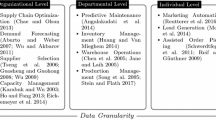Abstract
The efficient use of digital manufacturing data is a key leverage point of the factories of the future. Automatic analysis tools are required to provide smart and comprehensible information from large process databases collected on shopfloor machines-tools. In this paper, an original and dedicated approach is proposed for the data mining of HSM (High Speed Machining) flexible productions. It relies on an unsupervised learning (by statistical modelling of machining vibrations) for the classification of machining critical events and their aggregation. Moreover, a contextual clustering is suggested for a better data selection, and a visualization of machining KPI for decision aiding. It results in new leverages for decision making and process improvement; through automatic detection of the main faulty programs, tools or machine conditions. This analysis has been performed over two spindle lifespans (18 months) of industrial HSM production in aeronautics and results are presented, which assess the proposed approach.













Similar content being viewed by others
References
Abellan-Nebot, J. V., & Romero Subirón, F. (2010). A review of machining monitoring systems based on artificial intelligence process models. International Journal of Advanced Manufacturing Technology, 47(1), 1–21.
Ben Chabane, S., Stoica Maniu, C., Camacho, E., Alamo, T., & Dumur, D. (2016). Fault detection using set-membership estimation based on multiple model systems. In European control conference, Aalborg, Denmark (pp. 1105–1110).
Brecher, C., Quintana, G., & Rudolf, T. (2011). Use of NC kernel data for surface roughness monitoring in milling operations. International Journal of Advanced Manufacturing Technology, 53, 953–962.
Chen, J. C. (2000). An effective fuzzy-nets training scheme for monitoring tool breakage. Journal of Intelligent Manufacturing, 11(1), 85–101.
Choudhary, A. K., Harding, J. A., & Tiwari, M. K. (2009). Data mining in manufacturing: A review based on the kind of knowledge. Journal of Intelligent Manufacturing, 20(5), 501–521.
de Castelbajac, C., Ritou, M., Laporte, S., & Furet, B. (2014). Monitoring of distributed defects on HSM spindle bearings. Applied Acoustics, 77, 159–168.
Denkena, B., Dittrich, M. A., & Uhlich, F. (2016). Self-optimizing cutting process using learning process models. Procedia Technology, 26, 221–226.
Eleftheriadis, R. J., & Myklebust, O. (2015). Benchmark and best practice of IFaCOM industrial demonstrators. In 2015, 9th CIRP conference on intelligent computation in manufacturing engineering, procedia CIRP (Vol. 33, pp. 311–314).
Gao, R., Wang, L., Teti, R., Dornfeld, D., Kumara, S., & Mori, M. (2015). Cloud enabled prognosis for manufacturing. Annals of the CIRP, 64(2), 749–772.
IEC 62541-1. (2016). OPC unified architecture—Part 1: Overview and concepts. International Electrotechnical Commission.
Jin, X., Wah, B. W., Cheng, X., & Wang, Y. (2015). Significance and challenges of big data research. Big Data Research, 2, 59–64.
Karandikar, J. M., Abbas, A. E., & Schmitz, T. L. (2014). Tool life prediction using Bayesian updating. Part 1: Milling tool life model using a discrete grid method. Precision Engineering, 38(1), 18–27.
Lamraoui, M., Thomas, M., & El Badaoui, M. (2014). Cyclostationarity approach for monitoring chatter and tool wear in high speed milling. Mechanical Systems and Signal Processing, 44(1–2), 177–198.
Lauro, C. H., Brandão, L. C., Baldo, D., Reis, R. A., & Davim, J. P. (2014). Monitoring and processing signal applied in machining processes—A review. Measurement, 58, 73–86.
Lee, J., Bagheri, B., & Kao, H. A. (2015). A cyber-physical systems architecture for industry 4.0-based manufacturing systems. Manufacturing Letter, 3, 18–23.
Quintana, G., Garcia-Romeu, M. L., & Ciurana, J. (2011). Surface roughness monitoring application based on artificial neural networks for ball-end milling operations. Journal of Intelligent Manufacturing, 22(4), 607–617.
Ritou, M., Rabréau, C., Loch, S. Le, & Furet, B. (2018). Influence of spindle condition on the dynamic behaviour. Annals of the CIRP, 67(1), 413–416.
Ritou, M., Garnier, S., Furet, B., & Hascoët, J. Y. (2014). Angular approach combined to mechanical model for tool breakage detection by eddy current sensors. Mechanical Systems and Signal Processing, 44(1), 211–220.
Tangjitsitcharoen, S., Saksri, T., & Ratanakuakangwan, S. (2015). Advance in chatter detection in ball end milling process by utilizing wavelet transform. Journal of Intelligent Manufacturing, 26(3), 485–499.
Teti, R., Jemielniak, K., O’Donnell, G., & Dornfeld, D. (2010). Advanced monitoring of machining operations. Annals of the CIRP, 59(2), 717–739.
Vijayaraghavan, A., Huet, L., Dornfeld, D., Sobel, W., & Blomquist, B., & Conley, M. , (2009). Process planning and verification with MTConnect. Transactions of NAMRI/SMI, 37, 443–450.
Wang, G. F., Yang, Y. W., Zhang, Y. C., & Xie, Q. L. (2014). Vibration sensor based tool condition monitoring using support vector machine and locality preserving projection. Sensors and Actuators, A: Physical, 209, 24–32.
Whittaker, J. (2009). Graphical models in applied multivariate statistics. New York: Wiley.
Acknowledgements
The financial support of the French government on FUI QuaUsi and ANR SmartEmma (ANR-16-CE10-0005) is acknowledged. The authors also thank the contributions of the industrial partners.
Author information
Authors and Affiliations
Corresponding author
Rights and permissions
About this article
Cite this article
Godreau, V., Ritou, M., Chové, E. et al. Continuous improvement of HSM process by data mining. J Intell Manuf 30, 2781–2788 (2019). https://doi.org/10.1007/s10845-018-1426-7
Received:
Accepted:
Published:
Issue Date:
DOI: https://doi.org/10.1007/s10845-018-1426-7




